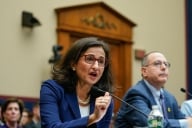You have /5 articles left.
Sign up for a free account or log in.
What was the most important media event of late August, 2017?
The Mayweather vs. McGregor fight? The season 7 finale of Game of Thrones? Taylor Swift's Look What You Made Me Do single, in which she disses Kanye West and Kim Kardashian?
No, no, and no.
The most important media event of late August was the release of the ECAR Trend Watch 2017: Which IT Trends Is Higher Education Responding To?, authored Bryan Alexander, Susan Grajek, and Joanna Lyn Grama.
This report stands out among so many other higher ed technology reports - those by professional associations or consultancies or sponsored by companies - for 3 reasons. First, the report is exceedingly well written and fun to read.Second, the report looks beyond new and shiny IT technologies to examine the interplay of larger postsecondary trends with advances in technology. Third, this report does not serve as a cheerleader for the role of technology in higher education, instead it takes a more critical, holistic, and nuanced approach.
The EDUCAUSE Center for Analysis and Research (ECAR) adopted a wise approach in choosing to examine the interaction of large postsecondary and technological trends, as opposed to narrowly focusing on the latest technologies. We don’t need any more reports on the coming VR/AR revolution, or the game-changing impact of personalized learning platforms. In taking this approach to look at trends rather than technologies, the authors note that: "Technologies are what IT organizations do. Trends, on the other hand, are widespread external factors that influence institutional and IT strategy and often spur the adoption of technologies.”
The report builds on surveys conducted last summer (2016) to identify 36 IT related trends that are impacting US colleges and universities. These trends were then classified into 4 levels of importance based on their prevalence across institutions. These levels are: most influential (influential at >=61% of institutions), taking hold (41-60%), worth understanding (21-40%), and limited impact (<21%).
The top 3 trends with the greatest influence (over 61% of colleges and universities) are: (1) continued complexity of security threats, (2) student success focus/imperatives, and (3) data-driven decision making. While these 3 developments were most prevalent across institutions, the trends discussed in the report of the 36 mentioned that most caught my eye were:
- Concerns about institutional sustainability or even survival
- IT as an agent of institutional transformation and innovation
- Blending of roles and blurring of boundaries between IT and academic/administrative areas
- Changing faculty roles (focus on advising and student success, growth in adjuncts, etc.)
- Bimodal IT (managing two separate IT delivery modes, one focused on stability and the other on agility
- Evaluation of technology-based instructional innovations
- Changing vendor–institution relationships (moving from a transactional to a strategic relationship)
- Cross-institutional partnerships and consortia
The discussion of these trends got my attention because they are all about organization change, innovation, and leadership. These are all issues in higher education that go well beyond the direct control of campus IT leadership, and instead are challenges where technology leaders must address through collaboration and partnerships.
The Trend Watch 2017 report represents a significant piece of evidence for anyone who wishes to argue that the requirements for higher ed IT leadership are now the same as overall higher leadership. In other words, effective postsecondary IT leaders will increasingly need to embrace a broad understanding of the forces and challenges that are impacting higher education. In the same way, colleges and universities that will be resilient and successful in the 21st century will bring IT leaders into the core ranks of strategic institutional decision makers.
If I were to critique this concise but important report, it would be that the conclusions and advice section is too narrowly focused on the higher ed IT community. The authors of the report argue that, "Taken together, these trends reveal campus technology departments to be in the continued throes of transformation." And that, "The structures and methods by which campus IT does its work are mutating.” This is true, but perhaps the observation is too narrow.
The entire postsecondary sector - every college and university - is in throes of transformation. To achieve institutional resilience while serving our stakeholders (students, all educators, parents, taxpayers, our communities, employers, etc. etc.) will require that change at every level. The whole institution, not just the IT unit, is mutating (or evolving) in order to thrive in this time of change.
The ECAR report could have reinforced the call for IT leaders to transform into institutional leaders. We need more campus leadership positions (deans, provosts, presidents) to be drawn from the ranks of those educators who came up the information technology ranks. At the same time, IT leaders should be recruited from sources other than traditional technology career paths - from the faculty and the library and from centers of teaching and learning (CTLs).
Trend Watch 2017: Which IT Trends Is Higher Education Responding To? is a publication that deserves both your attention, and wider discussion on our campuses.
What trends covered in the report resonate most with you?








